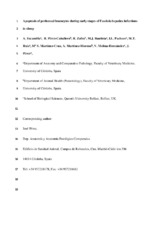Mostrar el registro sencillo del ítem
Apoptosis of peritoneal leucocytes during early stages of Fasciola hepatica infections in sheep
| dc.contributor.author | Escamilla, Alejandro | |
| dc.contributor.author | Pérez Caballero, Raúl | |
| dc.contributor.author | Zafra Leva, Rafael | |
| dc.contributor.author | Bautista, M.J. | |
| dc.contributor.author | Pacheco, I.L. | |
| dc.contributor.author | Ruiz, M.Teresa | |
| dc.contributor.author | Martínez Cruz, Setefilla | |
| dc.contributor.author | Martínez-Moreno, Álvaro | |
| dc.contributor.author | Molina Hernández, Verónica | |
| dc.contributor.author | Pérez, José | |
| dc.date.accessioned | 2019-12-03T12:30:36Z | |
| dc.date.available | 2019-12-03T12:30:36Z | |
| dc.date.issued | 2017 | |
| dc.identifier.uri | http://hdl.handle.net/10396/19174 | |
| dc.description.abstract | Several immunomodulatory properties have been described in Fasciola hepatica infections. Apoptosis has been shown to be an effective mechanism to avoid the immune response in helminth infections. The aim of the present work was to study apoptosis in peritoneal leucocytes of sheep experimentally infected with F. hepatica during the early stages of infection. Five groups (n = 5) of sheep were used. Groups 2–5 were orally infected with 200 metacercariae (mc) and sacrificed at 1, 3, 9 and 18 days post-infection (dpi), respectively. Group 1 was used as the uninfected control (UC). Apoptosis was detected using three different methods 1) immunocytochemistry (ICC) with a polyclonal antibody anti-active caspase-3; 2) an annexin V flow cytometry assay using the Annexin V-FITC/propidium iodide (PI); and 3) transmission electron microscopy (TEM). The differential leucocyte count revealed that the majority of peritoneal granulocytes were eosinophils, which increased significantly at 9 and 18 dpi with respect to the uninfected controls. The ICC study revealed that the percentage of caspase-3+ apoptotic peritoneal leucocytes increased significantly from 3 dpi onwards with respect to the uninfected controls. The flow cytometry annexin V assay detected a very significant (P < 0.001) increase of apoptotic peritoneal macrophages, lymphocytes and granulocytes, which remained higher than in the UC until 18 dpi. Transmission electron microscopy studies also confirmed the presence of apoptosis in peritoneal eosinophils at 18 dpi. This is the first report of apoptosis induced by F. hepatica in the peritoneal leucocytes of sheep in vivo. The results of this work suggest the importance of apoptosis induction for the survival of the juvenile parasites in the peritoneal migratory stages of infection. | es_ES |
| dc.format.mimetype | application/pdf | es_ES |
| dc.language.iso | eng | es_ES |
| dc.publisher | Elsevier | es_ES |
| dc.rights | https://creativecommons.org/licenses/by-nc-nd/4.0/ | es_ES |
| dc.source | Veterinary Parasitology 238, 49-53 (2017) | es_ES |
| dc.subject | Apoptosis | es_ES |
| dc.subject | Caspase-3 | es_ES |
| dc.subject | Annexin-V | es_ES |
| dc.subject | Peritoneal leucocytes | es_ES |
| dc.subject | Fasciola hepatica | es_ES |
| dc.subject | Sheep | es_ES |
| dc.title | Apoptosis of peritoneal leucocytes during early stages of Fasciola hepatica infections in sheep | es_ES |
| dc.type | info:eu-repo/semantics/article | es_ES |
| dc.relation.publisherversion | http://dx.doi.org/10.1016/j.vetpar.2017.03.015 | es_ES |
| dc.relation.projectID | info:eu-repo/grantAgreement/EC/H2020/635408 (PARAGONE) | es_ES |
| dc.relation.projectID | Gobierno de España. AGL2015-67023-C2-1-R | es_ES |
| dc.rights.accessRights | info:eu-repo/semantics/openAccess | es_ES |

